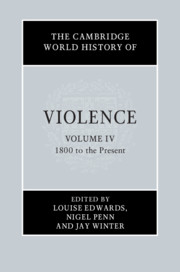Book contents
- The Cambridge World History of Violence
- The Cambridge History of Violence
- The Cambridge World History of Violence
- Copyright page
- Contents
- Figures and Maps
- Contributors to Volume IV
- Introduction to Volume IV
- Part I Race, Religion and Nationalism
- 1 Empires and Indigenous Worlds: Violence and the Pacific Ocean, 1760 to 1930s
- 2 Heresy and Banditry: Religious Violence in China since 1850
- 3 Violence, Non-Violence, the State and the Nation: India, 1858–1958
- 4 Racial Violence in the United States since the Civil War
- 5 Religion and Violence in Modern South Asia
- 6 Coercion and Violence in the Middle East
- Part II Intimate and Gendered Violence
- Part III Warfare, Colonialism and Empire in the Modern World
- Part IV The State, Revolution and Social Change
- Part V Representations and Constructions of Violence
- Index
- References
6 - Coercion and Violence in the Middle East
from Part I - Race, Religion and Nationalism
Published online by Cambridge University Press: 13 March 2020
- The Cambridge World History of Violence
- The Cambridge History of Violence
- The Cambridge World History of Violence
- Copyright page
- Contents
- Figures and Maps
- Contributors to Volume IV
- Introduction to Volume IV
- Part I Race, Religion and Nationalism
- 1 Empires and Indigenous Worlds: Violence and the Pacific Ocean, 1760 to 1930s
- 2 Heresy and Banditry: Religious Violence in China since 1850
- 3 Violence, Non-Violence, the State and the Nation: India, 1858–1958
- 4 Racial Violence in the United States since the Civil War
- 5 Religion and Violence in Modern South Asia
- 6 Coercion and Violence in the Middle East
- Part II Intimate and Gendered Violence
- Part III Warfare, Colonialism and Empire in the Modern World
- Part IV The State, Revolution and Social Change
- Part V Representations and Constructions of Violence
- Index
- References
Summary
This chapter analyses the various forms of coercion and violence that have played a central role in the shaping of the Middle East and that have affected all aspects of social life since the First World War. Notwithstanding its permanence in time and in space, the violence observed in the region is defined by distinct historical cycles. Each of these cycles began as a result of one or more violent disruptions that have a de-structuring and re-structuring impact beyond one country. Each is also determined by a specific ideological and political ‘microclimate’ and bears the mark of a given generation. The first cycle, which began with the dissolution of the Ottoman Empire and the division of its Arab provinces, continued until the foundation of the State of Israel. The second covers a period of thirty years from 1948 to 1979. The third begins in 1979 with the Camp David II Accords and the recognition of the State of Israel by Egypt, the Iranian Revolution, the Islamist insurgency at Mecca and the occupation of Afghanistan by the Soviet Army. The last cycle begins with the Arab revolutionary protests of 2011 and their disruptive effects on some societies.
Keywords
- Type
- Chapter
- Information
- The Cambridge World History of Violence , pp. 125 - 144Publisher: Cambridge University PressPrint publication year: 2020



